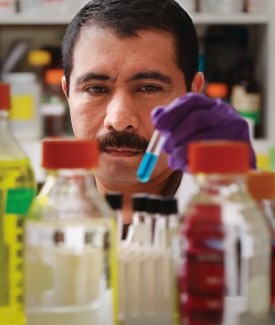Ob/Gyn Research
The Department of Obstetrics and Gynecology maintains a robust research program funded through private, government, and department sponsorships. Building on the legacies of Jack Pritchard, M.D., and Paul MacDonald, M.D., we believe that a partnership between clinicians and basic scientists is essential to understanding the underlying mechanisms that affect a woman’s health and to providing each woman with the most effective treatment options.
Clinical Research

Our faculty currently serve as members of several Ob/Gyn clinical research networks sponsored by the National Institutes of Health (NIH). These include the NIH Gynecologic Oncology Group, and the NIH Female Contraceptive Clinical Trials Network.
Our clinical faculty are dedicated to measuring health care outcomes to determine the most effective treatment protocols and are committed to rigorous controlled trials intended to better define best practices in our specialty. These studies run the gamut of the health problems we treat.
For instance, we led the $30 million effort of the Maternal-Fetal Medicine Units Network to screen 10,000 women for subclinical hypothyroidism and evaluate its impact.
In a local study to determine the risk of flu medications on pregnant women and their babies, we evaluated 82,336 medical records between 2003 and 2008 and identified 239 women with influenza who had been treated with antiviral medications during their pregnancy. Finding no significant risk to mothers or newborns, our faculty have continued to collect information about medication exposure and are also currently evaluating the risk of the influenza vaccine in all trimesters of pregnancy.
While disease increases risks during pregnancy, childbirth itself can lead to complications later in life. A study conducted by the Pelvic Floor Disorders Network found that an estimated 20 percent of childbearing women suffer from pelvic floor disorders as they age. Today, we are investigating the potential protective effects of local estrogen on the connective tissues of the pelvic floor in postmenopausal women undergoing surgery for pelvic organ prolapse.
Basic Research
Complementing our clinical research program is a well-focused basic research effort. Under sponsorship of the NIH and other organizations, our faculty members are conducting basic research in laboratories located throughout the department, including those of the Cecil H. and Ida Green Center for Reproductive Biology Sciences.
We recently received renewal of our multi-million dollar NIH program project grant, the Department’s longest-standing grant. The goal of this program project — designated, "Initiation of Human Labor: Prevention of Prematurity" — is to discover the biological mechanisms underlying the initiation of human labor.
Initially funded in 1974, the grant brought together obstetrician/gynecologists, biochemists, molecular biologists, and physiologists in an effort to elucidate the mechanisms of parturition and improve outcomes for newborns. Today, faculty in the Department and the Cecil H. and Ida Green Center for Reproductive Biology Sciences are working on diverse aspects of female reproductive biology and focusing on molecular mechanisms.
Continuing the effort to unravel the mechanisms of human parturition, investigations are focused on identifying the molecular events during pregnancy that cause remodeling of the cervix from a closed rigid structure to one that expands to enable passage of a term fetus.
Investigations are also underway to identify the mechanisms that cause fertility and infertility. Researchers are evaluating the role of the anterior pituitary in the onset of fertility, as well as its cessation during menopause. Others are examining the role of CYP17 (17-hydroxylase) in polycystic ovary syndrome (PCOS)—a hormonal disorder that can affect a woman’s ability to become pregnant.
Many women suffer from pelvic floor disorders as a consequence of childbirth. Using animal models, faculty and fellows are studying the functional anatomy of the pelvic floor, the effects of nerve injuries on voiding dysfunction and urinary and anal incontinence, and the effects of growth factors and myogenic stem cells on wound healing of the external anal sphincter.
